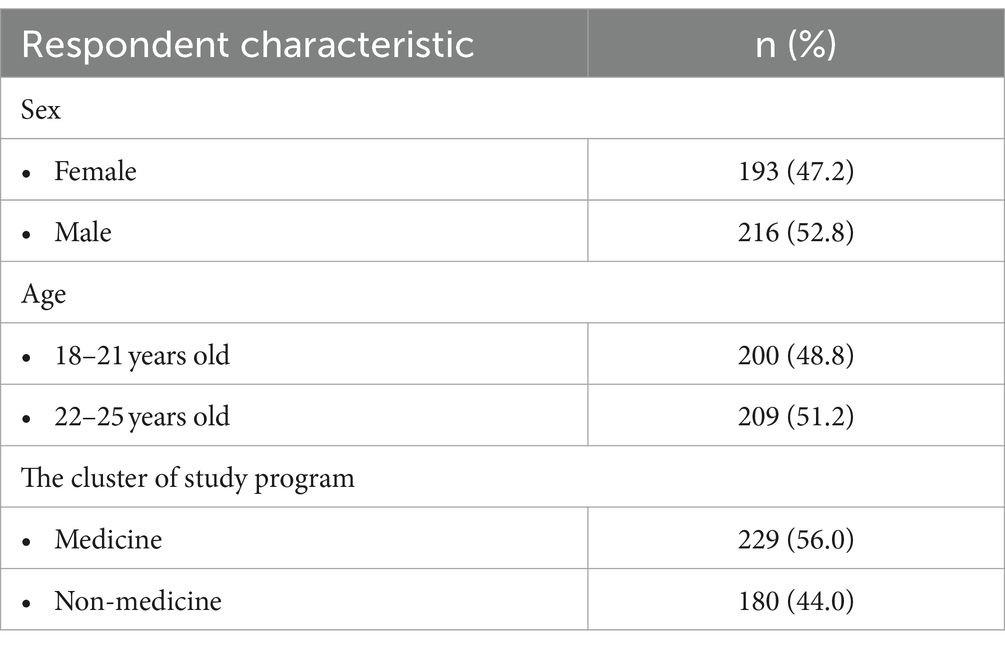- 1Department of Biology, Faculty of Medicine, Universitas Islam Sultan Agung, Semarang, Indonesia
- 2Department of Ophthalmology, Faculty of Medicine, Universitas Islam Sultan Agung, Semarang, Indonesia
- 3Sultan Agung Eye Center, Rumah Sakit Islam Sultan Agung, Semarang, Indonesia
- 4Faculty of Medicine, Universitas Islam Sultan Agung, Semarang, Indonesia
Introduction: Night blindness is the first sign of vitamin A deficiency (VAD), which can lead to blindness if left untreated. University students may be at risk of VAD-related night blindness due to unhealthy eating attitudes and inadequate vitamin A intake. This study aimed to determine the relationship between knowledge and attitudes toward vitamin A consumption affecting night blindness in university students.
Methods: This cross-sectional study involved 409 third-year university students of Universitas Islam Sultan Agung, Semarang, Indonesia. Participants completed questionnaires about socio-demographics, their knowledge of vitamin A, and attitudes toward vitamin A consumption. Night blindness symptoms among university students were assessed using the Low Luminance Questionnaire (LLQ), followed by a bivariate analysis of the Chi-Square test. Multivariate binary logistic regressions were used to determine whether the independent variables were associated with night blindness. A p-value less than 0.05 indicated significance.
Results: The prevalence of high-symptom night blindness was higher among males (26.4%) than females (5.7%). Out of 409 university students, 48 from the non-medicine cluster of the study program had a night blindness symptom. The prevalence was lower in students who studied in the medicine cluster program. The level of knowledge on vitamin A had a significant relationship with symptoms of night blindness [prevalence ratio (PR) = 2.239 (95% CI = 1.110–4.516)]. The attitudes toward vitamin A consumption were significantly associated with night blindness (PR = 2.560, 95% CI = 1.215–5.392).
Discussion: The results of this study show that the risk of night blindness in university students can be prevented by increasing their knowledge and attitudes toward consuming vitamin A-rich food. The university can provide health promotion and vitamin A supplementation to avoid night blindness among academia.
Introduction
Vitamin A is an essential nutrient that is crucial in maintaining eye health. Vitamin A’s active all-trans retinol metabolite endures a cycle that generates rhodopsin for light perception in the eye (1). Rhodopsin is involved in the dark adaptation process, allowing humans to see in the faint light. People with night blindness can see well during the day due to their cone cells, but they have difficulty seeing at night due to the ineffectiveness of their rod cells. Vitamin A deficiency (VAD) causes night blindness, resulting in the challenges of performing tasks in faint light or at night (1, 2).
Night blindness is the first symptom of VAD, which can lead to blindness if left untreated (3–5). Consuming foods deficient in vitamin A is common in developing countries (6, 7) due to poor eating habits. University students tend to consume high-calorie food selections, fast food snacks, fried food, and a low intake of daily fruits and vegetables (8). The low intake of vitamin A-rich foods among university students can increase the risk of ocular health disorders (9–13), especially night blindness.
Previous studies focus on vitamin A, and conclusive findings indicate that many university students suffer from vitamin A deficiency. The average daily intake of vitamin A among university students was about 2,500–5,000 IU. The treatments of 3 capsules containing 100,000 IU improved in dark adaptation, as indicated by the decrease of the final rod threshold of more than 0.15 log μμl (14). A recent study by Wan et al. reported no vitamin A deficiency in college students; however, all the students are vitamin E deficient (15). Knowledge, attitudes, and practices of medical students regarding vitamin consumption have been studied in China (16, 17), but we did not find vitamin A deficiency in medical students in Indonesia and its effects on night blindness symptoms.
Preventing VAD in university students, especially medical students, is vital in reducing errors in identifying color slides and specimens and investigating specific physical signs (18). The serial monitoring of electroretinogram (ERG) testing showed that vitamin A supplementation could restore VAD-associated night blindness in patients with nyctalopia complaints (19). Therefore, precautionary measures can be taken to improve knowledge and attitudes toward consuming vitamin A (20). This study aims to determine the relationship between the level of knowledge and attitudes toward vitamin A-rich foods consumption and night blindness symptoms in university students.
Materials and methods
Study design, population, and sample
This research is an analytical observational study with a cross-sectional design. Nine faculties at the Universitas Islam Sultan Agung, Semarang, Indonesia, involved in this study, categorized into 2 clusters. The study program of the Medicine cluster consisted of students enrolled in the Faculty of Medicine, Faculty of Dentistry, and Faculty of Nursing. In contrast, the non-medicine cluster included the Faculty of Law, Faculty of Islamic Studies, Faculty of Languages and Communication Sciences, Faculty of Engineering, and Faculty of Industry Engineering. The inclusion criteria were university students in 3rd-year bachelor study, while the exclusion criteria were missing written consent and night blindness before university. The sample size was 368, calculated using the following equation (21); where n is the minimum sample size required in the study, Z is the area under the curve corresponding to the desired confidence interval used in this study, i.e., 95% CI (1.96), P is the prevalence of vitamin A deficiency (VAD) in Indonesia (60%) (22), and d is the precision [difference between sample mean and population mean (+/− 5%)]. Assuming adding 10% of the sample size, 409 university students with bachelor’s degrees were involved in this study.
Data collection tool and measurement
The data collection was performed on 1–31 July 2022. All research instruments, including the consent forms and questionnaires, were available in Indonesian. The questionnaires were arranged in a Google form and shared through a WhatsApp group of students. The students filled out the questionnaire, and we provided online guidance when necessary.
The self-administered structured questionnaire consisted of sociodemographic characteristics (gender, age, and faculty), vitamin A knowledge, and attitudes toward vitamin A consumption (23). A knowledge-level questionnaire on vitamin A consumption consists of 20 questions about vitamin A deficiency’s sources, benefits, and consequences (Table 1) with the response of True or False. The level of knowledge is categorized as low-middle if the number of correct answers is 0–13 and high if the right answers are 14–20. Vitamin A consumption attitudes were asked through a questionnaire with 20 questions (Yes or No responses) related to the type, frequency, and habits of consuming foods that contain vitamin A (Table 2). Attitudes are categorized as low-middle (0–13 correct answers) and high (14–20 correct answers). Before conducting the research, the self-designed questionnaire was administered to 50 randomly selected university students for comprehension testing to ensure validity and reliability. The validity test showed that the corrected item-total correlation was >0.279, while the reliability test showed that Cronbach’s Alpha values of all items were > 0,279. Therefore, no significant changes were made due to the preliminary examination.
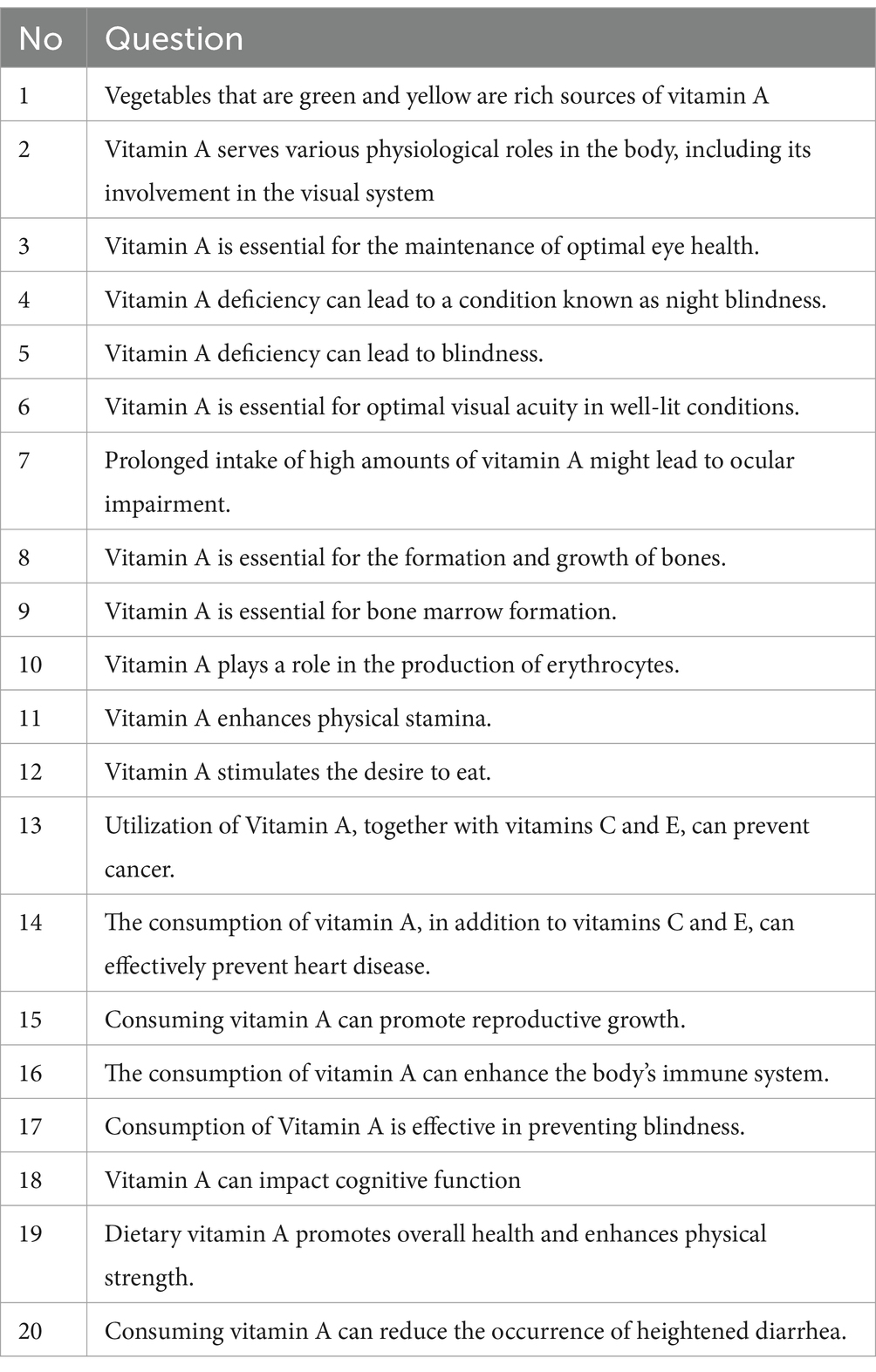
Table 1. The questions on knowledge regarding vitamin A administered to university students (n = 409).
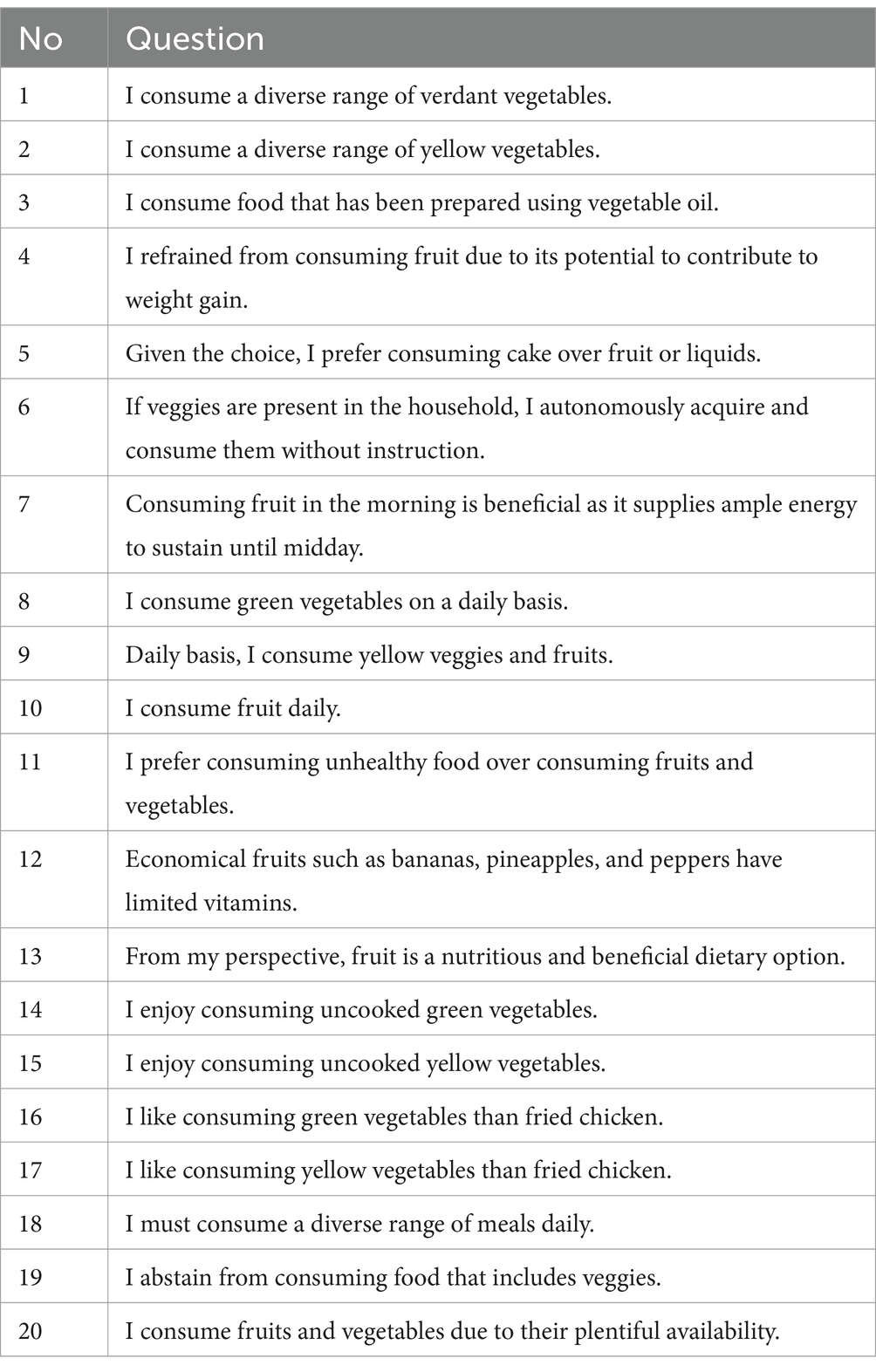
Table 2. The questions on attitudes regarding vitamin A administered to university students (n = 409).
Symptoms of night blindness were assessed by the Low Luminance Questionnaire (LLQ). This LLQ is a valid and reliable test for patient-centered assessment of visual function in a low luminance or mesopic setting (24, 25). The questionnaire was initially accessed in English and modified into Bahasa Indonesia (the national language). The LLQ is a 32-item questionnaire with six subscales related to low luminance settings: driving, mobility, extreme lighting, general dim lighting, and peripheral vision (Table 3). Each question can be answered with Yes or No. Symptoms are categorized as low-middle if the number of “Yes” answers is 0–21 and high for 22–32.
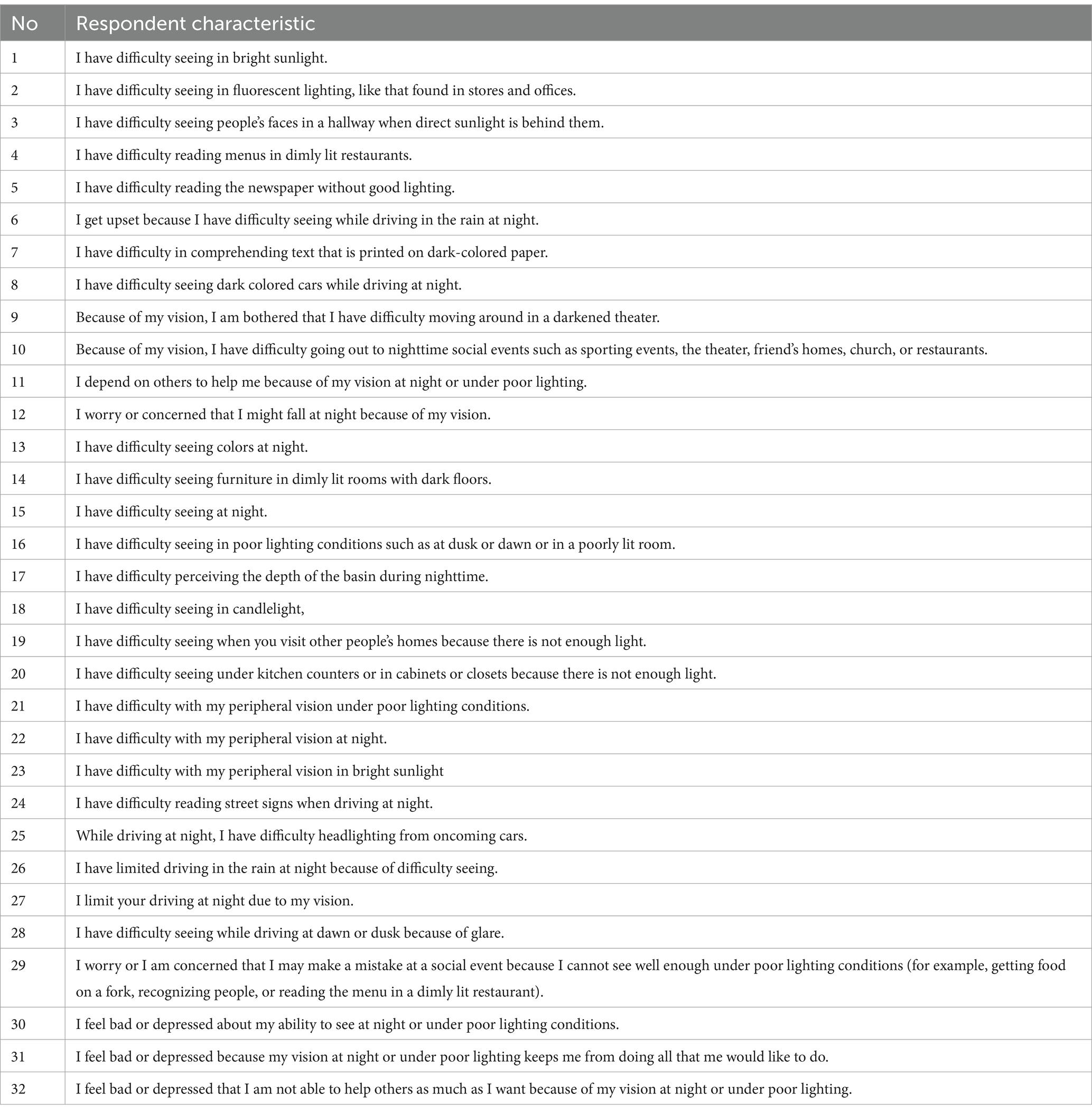
Table 3. The questions on symptoms of night blindness using the Low Luminance Questionnaire (LLQ) administered to university students (n = 409).
Data analysis
Data were analyzed using IBM SPSS Statistics version 25.0 for Windows. A bivariate analysis of the chi-square test was carried out to explore the relationship between knowledge and attitudes toward vitamin A consumption with the appearance of symptoms of night blindness. Multivariate analysis of logistic regression was used to determine the most influential variables on the signs of night blindness.
Results
Table 4 shows the sociodemographic data of the participants. A total of 409 university students participated in this study, of which 47.2% were female and 52.8% were female. A total of 56% respondents studied at the Medicine Cluster Study Programme (Medicine, Dentistry, and Nursing), while 44% were enrolled in the Non-Medicine Cluster (Islamic Studies, Law, Language and Communication Sciences, Economics, Electrical Engineering, and Industrial Engineering).
The prevalence of high symptoms of night blindness was higher among males (26.4%) than females (5.7%). The prevalence of night blindness did not differ significantly between the two age groups (p > 0.05). Out of 180 university students from the non-medicine cluster of the study program, 48 (26.7%) students had a night blindness symptom. The prevalence was lower in students who studied in the medicine cluster of the study program (8.7% out of 229 students) (Table 5). The level of knowledge on vitamin A had a significant relationship to the symptoms of night blindness with a prevalence ratio (PR) of 2.239 (95% CI = 1.110–4.516). However, it can be seen that 19% out of 295 students with a high level of knowledge about vitamin A showed a symptom of night blindness. The attitudes toward vitamin A consumption were significantly associated with night blindness (PR = 2.560, 95% CI = 1.215–5.392). However, 21.2% of the 273 students with high attitudes toward vitamin A consumption showed high symptoms of night blindness.
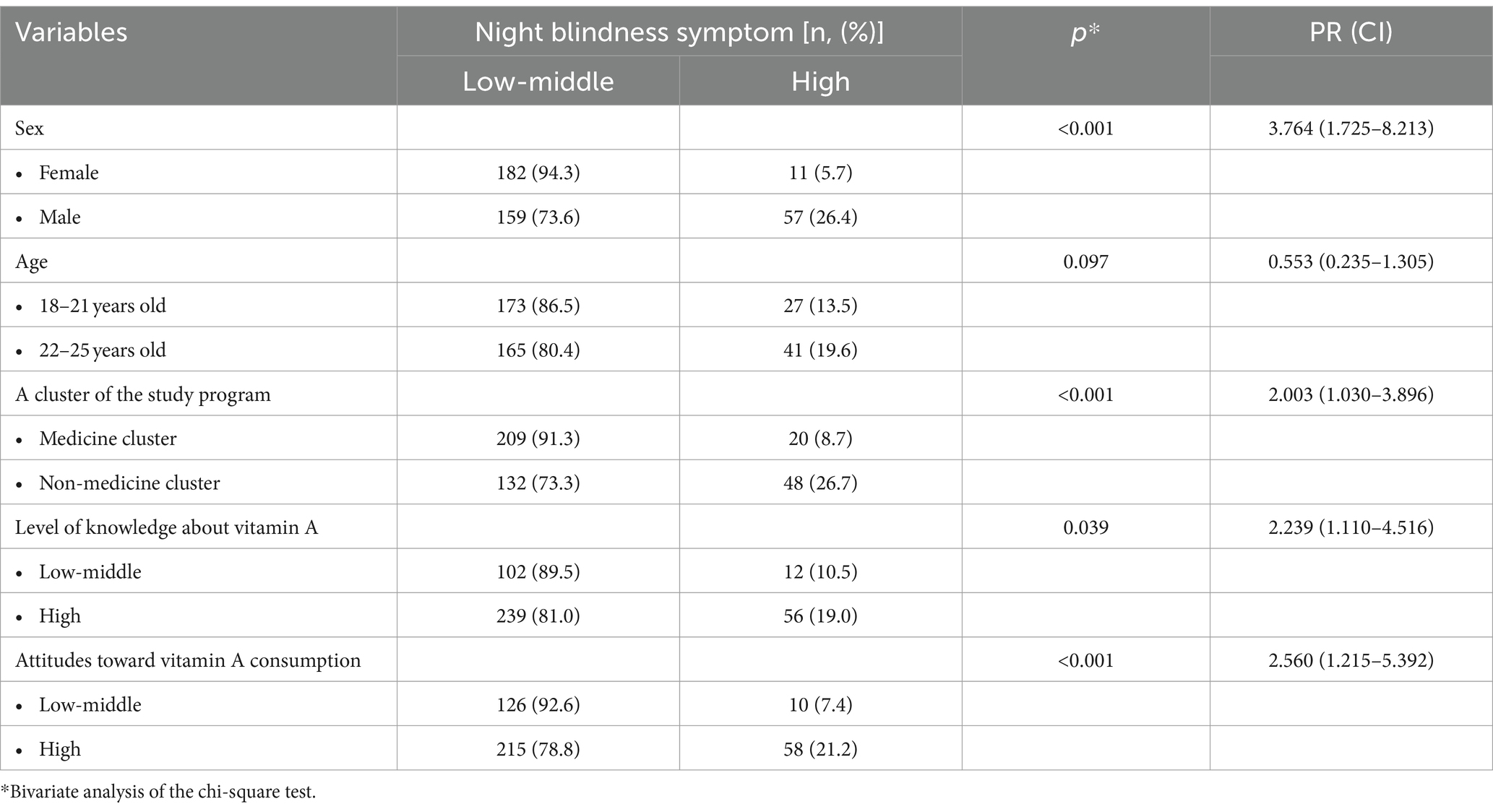
Table 5. The relationship between sex, age, a cluster of study program level of knowledge about vitamin A and attitudes toward vitamin A consumption and night blindness symptom.
Discussion
This cross-sectional study aimed to determine the association between knowledge and attitudes on vitamin A consumption and night blindness symptoms among university students. Similar studies have been carried out in Indonesia to determine the relationship between the knowledge of mothers and attitudes toward vitamin A supplementation to their children (22, 26, 27). However, in this study, we focus on the prevalence of night blindness-related vitamin A deficiency (VAD) due to unhealthy eating attitudes with inadequate vitamin A intake in university students. College students may experience hidden malnutrition for certain essential nutrients, including vitamin A and vitamin E (28).
This study reported that the prevalence of night blindness was five times higher in male than female students. Similar results were also seen in a cross-sectional study by Faruqui et al., who reported that the prevalence of color vision deficiency (CVD) in male medical students was higher than in female medical students (29). The risk of blindness tends to be higher in men due to a mutation in the nyctalopia gene (NYX) on Xp11.4 and X chromosome-related deficiencies in men (30). Night blindness in male students may also led by screen time. The prevalence of night blindness did not differ significantly between the two age groups because the participants were enrolled in the same year of their bachelor’s study. However, in children, age was mainly related to the prevalence of night blindness (31). Another study by Shrestha et al. reported that low awareness of common ocular conditions, including night blindness, is associated with factors such as female gender, old age, lower levels of education, and rural habitation. Thus, health literacy promotion can be helpful for eye care services (32).
The participants with a low-middle level of knowledge on vitamin A had two times higher risk of night blindness symptoms. It can also be seen from the result of the association between the cluster of the study program and night blindness. The university students from the non-medicine cluster of the study program had a higher prevalence of night blindness symptoms (26.7% out of 180 students) than those who studied in the medicine cluster of the study program (8.7% out of 229 students). It can be caused by the different knowledge about vitamin A during their study. Changing practices requires continuous long-term education (33). Rachman et al. reported that fruit and vegetable consumption behavior among senior high schools in Bali, Indonesia, was related to attitude, nutritional knowledge, food availability, media exposure, and parent’s income (34). People with a greater understanding of vitamin A are typically more aware of vitamin A’s benefits for eye health; thus, education in society is needed to improve knowledge, attitudes, and practices toward vitamin A consumption (23).
Nineteen percent out of 295 students with a high level of knowledge about vitamin A and 8.7% out of 209 students from the medicine cluster of study program showed a symptom of night blindness. We speculate that they could have suffered from night blindness due to stress, heavy workload, and lack of time; university students tend to make poor food choices. Thus, it is challenging for them to adhere to vitamin A-rich food. A student enrolled in the medicine cluster of the study program has a stressful environment due to the extensive curricula, numerous academic requirements, and frequent, complex, and various types of examinations (35). It can also be caused by their long screen time. Dixit et al. reported that screen time was associated with adolescents’ increasing prevalence of poor, uncorrected visual acuity (36).
The attitudes toward vitamin A consumption were significantly associated with night blindness (odds ratio = 2.560, 95% CI = 1.215–5.392). However, 21.2% of the 273 students with high attitudes toward vitamin A consumption showed high symptoms of night blindness. This study is consistent with a previous study stating that attitudes did not always translate into practice; for example, although 60.5% agreed on the adverse effect of interruption during mealtime on food intake, they do not interrupt a patient during mealtime (37). Adequate vitamin A supplementation is reported to be an effective treatment of night blindness because vitamin A deficiency tends to be reversible (5). The Food and Nutrition Board, Institute of Medicine—National Academy of Sciences advises that the Recommended Daily Allowance (RDA) for >18 years of age people is 700 mg/d for females and 900 mg/d as retinol activity equivalents (RAE’s), while the Tolerable Upper Intake Level (ULs) for males is 3,000 mg/d (38).
This study was subject to several limitations. First, this study was a cross-sectional design; thus, it is difficult to determine whether the low level of knowledge and attitudes of vitamin A preceded the night blindness. Second, data collection by questionnaire may have led to recall bias and misreporting of vitamin A-rich food consumption. Regarding the attitude questionnaires toward vitamin A consumption, no quantitative data on daily vitamin A-rich food portions or vitamin A supplementation was available to identify the association between the practices and night blindness of university students. Furthermore, unfortunately, we do not physically observe the night blindness symptoms or measure the serum retinol level of our respondents. Although this study represents a private university in Semarang, Indonesia, and thus is not representative of all university students, our study was the first to show vitamin A consumption among university students and its association with night blindness in Indonesia.
Conclusion
The results of this study show that the risk of night blindness in university students can be prevented by increasing their knowledge and attitudes toward consuming vitamin A-rich food. Continuous education on the role of a healthy diet is needed to educate undergraduate students, especially those studying in the non-medicine cluster of the study program. To improve this practice, the university can provide health promotion and vitamin A supplementation to prevent night blindness in academia.
Data availability statement
The original contributions presented in the study are included in the article/supplementary material, further inquiries can be directed to the corresponding author.
Ethics statement
The studies involving humans were approved by the Institutional Review Board (or Ethics Committee) of the Faculty of Medicine at Universitas Islam Sultan Agung. The studies were conducted in accordance with the local legislation and institutional requirements. The participants provided their written informed consent to participate in this study.
Author contributions
SS: Conceptualization, Data curation, Formal analysis, Funding acquisition, Investigation, Methodology, Project administration, Resources, Software, Validation, Visualization, Writing – original draft, Writing – review & editing. HP: Funding acquisition, Methodology, Supervision, Writing – review & editing. AR: Methodology, Supervision, Writing – review & editing. ML: Data curation, Formal analysis, Investigation, Writing – review & editing.
Funding
The author(s) declare financial support was received for the research, authorship, and/or publication of this article. This research was funded by the Lembaga Penelitian dan Pengabdian Masyarakat Universitas Islam Sultan Agung with contract number 246/B.1/SA-LPPM/VII/2021.
Conflict of interest
The authors declare that the research was conducted in the absence of any commercial or financial relationships that could be construed as a potential conflict of interest.
Publisher’s note
All claims expressed in this article are solely those of the authors and do not necessarily represent those of their affiliated organizations, or those of the publisher, the editors and the reviewers. Any product that may be evaluated in this article, or claim that may be made by its manufacturer, is not guaranteed or endorsed by the publisher.
References
2. Sanif, R, and Nurwany, R. Vitamin A dan perannya dalam siklus sel. J Kedokt dan Kesehat Publ Ilm Fak Kedokt Univ Sriwij. (2017) 4:83–8. https://ejournal.unsri.ac.id/index.php/jkk/article/view/6100
3. WHO. Vitamin A deficiency. (2009) Blindness is one of, damaging the retina and corneahttps://www.who.int/data/nutrition/nlis/info/vitamin-a-deficiency#:~:text=Night (Accessed May 12, 2023).
4. Hodge, C, and Taylor, C. Vitamin A deficiency. StatPearls (2023) Available at: https://www.ncbi.nlm.nih.gov/books/NBK567744/ (Accessed May 12, 2023).
5. Clifford, LJ, Turnbull, AMJ, and Denning, AM. Reversible night blindness – a reminder of the increasing importance of vitamin A deficiency in the developed world. J Optom. (2013) 6:173–4. doi: 10.1016/j.optom.2013.01.002
6. Akhtar, S, Ahmed, A, Randhawa, MA, Atukorala, S, Arlappa, N, Ismail, T, et al. Prevalence of vitamin A deficiency in South Asia: causes, outcomes, and possible remedies. J Health Popul Nutr. (2013) 31:413–23. doi: 10.3329/jhpn.v31i4.19975
7. Abrha, T, Girma, Y, Haile, K, Hailu, M, and Hailemariam, M. Prevalence and associated factors of clinical manifestations of vitamin A deficiency among preschool children in Asgede-Tsimbla rural district, North Ethiopia, a community based cross sectional study. Arch Public Heal. (2016) 74:4. doi: 10.1186/s13690-016-0122-3
8. Chen Yun, T, Ahmad, SR, and Soo Quee, DK. Dietary habits and lifestyle practices among university students in Universiti Brunei Darussalam. Malaysian J Med Sci. (2018) 25:56–66. doi: 10.21315/mjms2018.25.3.6
9. Atmadja, TFA, Yunianto, AE, Yuliantini, E, Haya, M, Faridi, A, and Suryana, S. Gambaran sikap dan gaya hidup sehat masyarakat Indonesia selama pandemi Covid-19. AcTion Aceh Nutr J. (2020) 5:195–202. doi: 10.30867/action.v5i2.355
10. Haryanti, S, Kartikawati, A, and Sulietyono, B. Pengaruh Gaya Hidup dan Pola Makan Terhadap Myopia pada Guru Sekolah Dasar di Jakarta Pusat. Pros Semin Nas Pengabdi Masy. (2020) 2021:262–70. https://ocs.machung.ac.id/index.php/senam/article/view/13
11. Ardella, KB. Risiko Kesehatan Akibat Perubahan Pola Makan Dan Tingkat Aktivitas Fisik Selama Pandemi Covid-19. J Med Hutama. (2020) 2:292–7. https://jurnalmedikahutama.com/index.php/JMH/article/view/73
12. Dewi, N, Maemunah, N, and Putri, RM. Gambaran Asupan Nutrisi Dimasa Pandemi Pada Mahasiswa. Care J Ilm Ilmu Kesehat. (2020) 8:369–82. doi: 10.33366/jc.v8i3.1959
13. Almousa, LA, and Alagal, RI. Effects of the COVID-19 pandemic on diet and physical activity and the possible influence factors among Saudi in Riyadh. Front Nutr. (2022) 9:1029744. doi: 10.3389/fnut.2022.1029744
14. Doraiswami, S, and Yudkin, J. Deficiency of vitamin A in university students. Br Med J. (1948) 2:708–10. doi: 10.1136/bmj.2.4580.708
15. Wan, Z, Wang, L, Xu, Y, Wang, Y, Zhang, T, Mao, X, et al. Hidden hunger of vitamin E among healthy college students: a cross- sectional study. Endocrine Metab Immune Disord Drug Targets. (2021) 21:1025–30. doi: 10.2174/1871530321666210101165648
16. Zhou, M, Zhuang, W, Yuan, Y, Li, Z, and Cai, Y. Investigation on vitamin D knowledge, attitude and practice of university students in Nanjing, China. Public Health Nutr. (2016) 19:78–82. doi: 10.1017/S1368980015000373
17. Du, S-S, Jiang, Y-S, Chen, Y, Li, Z, Zhang, Y-F, Sun, C-H, et al. Development and applicability of an internet-based diet and lifestyle questionnaire for college students in China: a cross-sectional study. Medicine. (2015) 94:e2130. doi: 10.1097/MD.0000000000002130
18. Alamoudi, NB, AlShammari, RZ, AlOmar, RS, AlShamlan, NA, Alqahtani, AA, and AlAmer, NA. Prevalence of color vision deficiency in medical students at a Saudi university. J Fam Community Med. (2021) 28:196–201. doi: 10.4103/jfcm.jfcm_235_21
19. Poornachandra, B, Jayadev, C, Sharief, S, and Shetty, R. Serial ERG monitoring of response to therapy in vitamin A deficiency related night blindness. BMJ Case Rep. (2022) 15:e247856. doi: 10.1136/bcr-2021-247856
20. Sefrina, LR, Briawan, D, Sinaga, T, and Permaesih, D. Estimasi Asupan Karotenoid pada Usia Dewasa di Indonesia. J Gizi dan Pangan. (2017) 12:1–8. doi: 10.25182/jgp.2017.12.1.1-8
21. Charan, J, and Biswas, T. How to calculate sample size for different study designs in medical research? Indian J Psychol Med. (2013) 35:121–6. doi: 10.4103/0253-7176.116232
22. Christian, EC, Ayu Sangging, PR, and Himayani, R. Night blindness: the relationship of consumption of vitamin A in Indonesia. Med Prof J Lampung. (2023) 13:42–5. doi: 10.53089/medula.v13i4.1.679
23. Alfarizqi, MZ, and Setiawan, D. Pengaruh Pengetahuan, Sikap, dan Peran Tenaga Kesehatan terhadap Pemberian Vitamin A. Nutr J Pangan, Gizi, Kesehat. (2020) 1:60–5. doi: 10.30812/nutriology.v1i2.976
24. Owsley, C, McGwin, G Jr, Scilley, K, and Kallies, K. Development of a questionnaire to assess vision problems under low luminance in age-related maculopathy. Invest Ophthalmol Vis Sci. (2006) 47:528–35. doi: 10.1167/iovs.05-1222
25. Owsley, C, and McGwin, G. Vision-targeted health related quality of life in older adults: patient-reported visibility problems in low luminance activities are more likely to decline than daytime activities. BMC Ophthalmol. (2016) 16:92. doi: 10.1186/s12886-016-0274-5
26. Mahlida, M, Ningsih, F, and Ovany, R. Hubungan Tingkat Pengetahuan Ibu tentang vitamin a dengan Pemberian Kapsul vitamin A pada Balita. J Surya Med. (2022) 8:120–4. doi: 10.33084/jsm.v8i1.3452
27. Fauziah, F, and Rahmawati, R. Hubungan Antara Tingkat Pengetahuan Ibu Dengan Pemberian Vitamin A Dosis Tinggi Pada Balita Di Puskesmas Segiri Samarinda. Bunda Edu-Midwifery J. (2021) 4:39–43. doi: 10.54100/bemj.v4i2.49
28. Al-Qahtani, MH. Dietary habits of Saudi medical students at University of Dammam. Int J Health Sci. (2016) 10:353–62. doi: 10.12816/0048729
29. Faruqui, S, Jain, R, Harne, A, Sharma, R, Bawaria, S, and Agarwal, R. A study of the prevalence of colour vision deficiency (CVD) in medical students and its effect on their professional training. Eur J Mol Clin Med. (2022) 9:1469–74. https://ejmcm.com/issue-content/a-study-of-the-prevalence-of-colour-vision-deficiency-cvd-in-medical-students-and-its-effect-on-their-professional-training-10914
30. Kim, AH, Liu, P-K, Chang, Y-H, Kang, EY-C, Wang, H-H, Chen, N, et al. Congenital stationary night blindness: clinical and genetic features. Int J Mol Sci. (2022) 23:14965. doi: 10.3390/ijms232314965
31. Bantihun, A, Gonete, KA, Getie, AA, and Atnafu, A. Child night blindness and Bitot’s spots are public health problems in lay Armachiho District, Central Gondar zone, Northwest Ethiopia, 2019: a community-based cross-sectional study. Int J Pediatr. (2020) 2020:5095620–11. doi: 10.1155/2020/5095620
32. Shrestha, MK, Guo, CW, Maharjan, N, Gurung, R, and Ruit, S. Health literacy of common ocular diseases in Nepal. BMC Ophthalmol. (2014) 14:2. doi: 10.1186/1471-2415-14-2
33. Cai, Z, Luo, X, Xu, X, Shi, Z, Reis, C, Sharma, M, et al. Effect of WeChat-based intervention on food safety knowledge, attitudes and practices among university students in Chongqing, China: a quasi-experimental study. J Health Popul Nutr. (2023) 42:28. doi: 10.1186/s41043-023-00360-y
34. Rachman, BN, Mustika, IG, and Kusumawati, IGAW. Faktor yang berhubungan dengan perilaku konsumsi buah dan sayur siswa SMP di Denpasar. J Gizi Indones. (2017) 6:9–16. doi: 10.14710/jgi.6.1.9-16
35. Sreeramareddy, CT, Shankar, PR, Binu, VS, Mukhopadhyay, C, Ray, B, and Menezes, RG. Psychological morbidity, sources of stress and coping strategies among undergraduate medical students of Nepal. BMC Med Educ. (2007) 7:26. doi: 10.1186/1472-6920-7-26
36. Dixit, R, Jindal, M, Gupta, P, and Dubey, A. Excessive usage of illuminated screen a risk factor for myopia in adolescent population. J Curr Med Appl Sci. (2016) 10:173–6.
37. Shakhshir, M, and Alkaiyat, A. Healthcare providers’ knowledge, attitude, and practice on quality of nutrition care in hospitals from a developing country: a multicenter experience. J Health Popul Nutr. (2023) 42:15. doi: 10.1186/s41043-023-00355-9
38. Busty, A. The mechanism for vitamin A improvements in night vision. (2015). Available at: https://www.ebmconsult.com/articles/vitamin-a-eye-vision-mechanism (Accessed December 4, 2023).
Keywords: vitamin A deficiency, night blindness, education, knowledge, attitudes
Citation: Suparmi S, Prasetya H, Rahmawati A and Lailaulaan MS (2024) Knowledge and attitudes about vitamin A consumption and its relationship with night blindness in university students. Front. Med. 11:1309837. doi: 10.3389/fmed.2024.1309837
Edited by:
Alberto Modenese, University of Modena and Reggio Emilia, ItalyReviewed by:
Irma Ruslina Defi, Padjadjaran University, IndonesiaLia Kusmita, Semarang Pharmacy Foundation College of Pharmacy Campus, Indonesia
Copyright © 2024 Suparmi, Prasetya, Rahmawati and Lailaulaan. This is an open-access article distributed under the terms of the Creative Commons Attribution License (CC BY). The use, distribution or reproduction in other forums is permitted, provided the original author(s) and the copyright owner(s) are credited and that the original publication in this journal is cited, in accordance with accepted academic practice. No use, distribution or reproduction is permitted which does not comply with these terms.
*Correspondence: Suparmi Suparmi, c3VwYXJtaUB1bmlzc3VsYS5hYy5pZA==
 Suparmi Suparmi
Suparmi Suparmi Harka Prasetya2,3
Harka Prasetya2,3